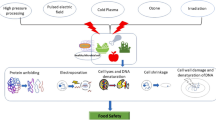Abstract
Optimization of processing conditions (temperature 122 to 136°C, vacuum pressure 9.91 to 19.91 cmHg, and frying time 3 to 9 min) during vacuum frying of plantain chips was investigated using a Box-Behnken experimental design with response surface methodology (RSM). Models for various responses were developed and optimized frying conditions using numerical solutions were established. Optimized vacuum fried samples were compared with atmospheric fried samples based on the concept of equivalent thermal driving force (ETDF). Frying parameters had significant (p<0.05) effects on the moisture content, texture, and color with a coefficient of determination (R 2) for quadratic model responses varying between 0.53 and 0.99. Optimum vacuum frying conditions for plantain chips were a frying temperature of 133°C, vacuum pressure of 9.91 cmHg, and frying time of 6 min based on desirability concepts. Vacuum fried plantain chips had more acceptable sensory properties, based on ETDF values, than atmospheric fried samples.
Similar content being viewed by others
References
Chatlada K, Anuvat J, Porjai T. Changes in characteristics of palm oil during vacuum and atmospheric frying conditions of sweet potato. Kasetsart J. (Nat. Sci.) 43: 298–304 (2009)
Rimac-Brncic SR, Lelas, V, Rade D, Simundic B. Decreasing of oil absorption in potato strips during deep-fat frying. J. Food Eng. 64: 237–241 (2004)
Fan L, Zhang M, Mujumdar AS. Vacuum frying of carrots chips. Dry. Technol. 23: 645–656 (2005)
Alvarez MD, Morillo MJ, Canet W. Characterization of the frying process of fresh and blanched potato strips using response surface methodology. Eur. Food Res. Technol. 211: 326–335 (2000)
Sobukola OP, Awonorin SO, Sanni LO, Bamiro FO. Optimization pre-fry drying of yam slices using response surface methodology. J. Food Process Eng. 33: 626–648 (2010)
Garayo J, Moreria R. Vacuum frying of potato chips. J. Food Eng. 55: 181–191 (2002)
Shyu S, Hau L, Hwang L. Effect of vacuum frying on the oxidative stability of oils. J. Am. Oil Chem. Soc. 75: 1393–1398 (1998)
FAO. The State of Food Insecurity in the World 2004. Food and Agriculture Organization of the United Nations, Rome, Italy (2004)
Marriot J, Lancaster PA. Bananas and plantains. pp. 85–143. In: Handbook of Tropical Food. Chan HT (ed). Dekker, New York, NY, USA (1983)
Robinson JC. Bananas and Plantains. CAB International, London, UK (1996)
Mariscal M, Bouchon P. Comparison between atmospheric and vacuum frying of apple slices. Food Chem. 107: 1561–1569 (2008)
AOAC. Official Methods of Analysis of AOAC Intl. 16th ed. Method No. 963.15. The Association of Official Analytical Chemists, Arlington, VA, USA. p. 1588 (1995)
da Silva PF, Moreira RG. Vacuum frying of higher quality fruit and vegetable-based snacks. Food Sci. Technol-LEB. 41: 1758–1767 (2008)
AOAC. Official Methods of Analysis of AOAC Intl. 17th ed. Method No. 934.06. Association of Official Analytical Chemists, Washington, DC, USA (2000)
Yam K, Papadakis S. A simple digital imaging method for measuring and analyzing color of food surfaces. J. Food Eng. 61: 137–142 (2004)
Ihekoronye AI, Ngoddy PO. Integrated Food Science and Technology for the Tropics. Macmillan Publishers Ltd., London, UK. p. 386 (1986)
Ushakumari SR, Rastogi NK, Malleshi NG. Optimization of process variables for the preparation of expanded finger millet using response surface methodology. J. Food Eng. 82: 35–42 (2007)
Kemp SE, Hollywood T, Hort J. Sensory Evaluation, a Practical Handbook. John Wiley & Sons Ltd., West Sussex, UK. p. 55 (2009)
Myers R, Montgomery DC. Response Surface Methodology. Wiley, New York, NY, USA. p. 87 (2002)
Adobe Systems. Adobe Photoshop 7.0. User Guide. Adobe Systems Inc., San Jose, CA, USA (2002)
Chakraborty SK, Kumbhar BK, Sarkar BC. Process parameter optimization for instant pigeon peadhal using response surface methodology. J. Food Eng. 81: 171–178 (2007)
Krokida MK, Oreopoulou V, Maroulis ZB, Marinos-Kouris D. Deep-fat frying of potato strips-quality issues. Dry. Technol. 19: 879–935 (2001)
Nourian F. Ramaswamy HS. Kinetics of quality changes during cooking and frying of Potatoes: Part 1. Texture. J. Food Process Eng. 26: 377–394 (2003)
Bouchon P, Aguilera JM, Pyle DL. Structure oil-absorption relationships duringdeep-fat frying. J. Food Sci. 68: 2711–2716 (2003)
Marquez G, Anon M. Influence of reducing sugars and amino acid in the colour development of fried potatoes. J. Food Sci. 51: 157–160 (1986)
Dueik V, Robert P, Bouchon P. Vacuum frying reducs oil uptake and improves the quality oparameters of carrot crisps. Food Chem. 119: 1143–1149 (2000)
Sobukola OP, Dueik V, Munoz L, Bouchon P. Comparison of vacuum and atmospheric deep-fat frying of wheat starch and gluten based snacks. Food Sci. Biotechnol. 22 (Suppl.): 177–182 (2013)
Troncoso E, Pedreschi F, Zuniga RN. Comparative study of physical and sensory properties of pre-treated potato slices during vacuum and atmospheric frying. Food Sci. Technol-LEB. 42: 187–195 (2009)
Tan KJ. Mittal GS. Physicochemical properties changes of donuts during vacuum frying. Int. J. Food Prop. 9: 85–98 (2006)
Troncoso E, Pedreschi F. Modeling water loss and oil uptake during vacuum frying of pretreated potato slices. Food Sci. Technol-LEB. 42: 1164–1173 (2007)
Sobukola OP, Dueik V, Bouchon P. Understanding the effect of vacuum level in structure development and oil absorption in vacuum-fried wheat starch and gluten based snacks. J. Food Bioprocess Tech. 6: 2010–2017 (2013)
Yagmur R. Paulo D. Rosana GM. Two-stage frying process for high-quality sweet-potato chips. J. Food Eng. 118: 31–40 (2013)
Krokida MK, Oreopoulou V, Maroulis ZB, Marinos-Kouris D. Deep-Fat frying of potato strips-quality issues. Dry. Technol. 19: 879–935 (2001)
Author information
Authors and Affiliations
Corresponding author
Rights and permissions
About this article
Cite this article
Akinpelu, O.R., Idowu, M.A., Sobukola, O.P. et al. Optimization of processing conditions for vacuum frying of high quality fried plantain chips using response surface methodology (RSM). Food Sci Biotechnol 23, 1121–1128 (2014). https://doi.org/10.1007/s10068-014-0153-x
Received:
Revised:
Accepted:
Published:
Issue Date:
DOI: https://doi.org/10.1007/s10068-014-0153-x




